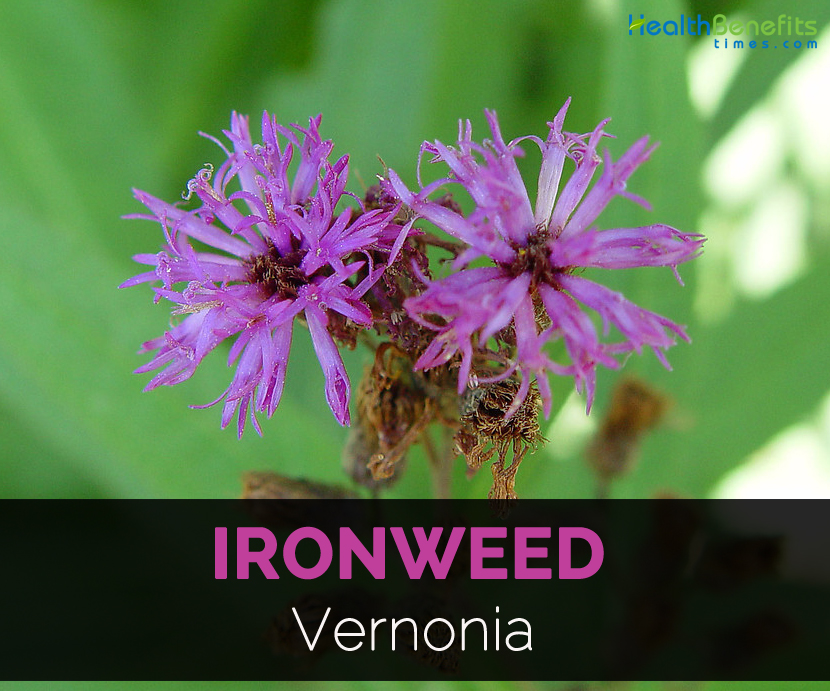Ironweed belongs to the member of Asteraceae with only disk or tubular flowers. Flowers are purple tubular and form in groups of 20-40 or more head. Flower has 5-lobed tubular corolla, 5 stamens and pistil with inferior ovary and slender or thread like style. Fruits are cypselae or achenes which are elongate, ribbed, cylindrical and hairy. Individual flower heads are subtended by cup of leafy bracts which are known as involucre. Involucre of an ironweed flower head is bell shaped or oblong with individual purplish green bracts with long bristle like tip arranged in a woven pattern. Individual heads are on short stems arranged in a flat topped inflorescence pattern described as corymbose cyme.
Facts About Ironweed
| Ironweed Quick Facts | |
|---|---|
| Name: | Ironweed |
| Scientific Name: | Vernonia |
| Origin | Native to the eastern United States, from Florida to Massachusetts and west to Tennessee, Alabama, and West Virginia. |
| Shapes | Achenes, elongate, cylindrical, ribbed, hairy |
| Name | Ironweed |
|---|---|
| Scientific Name | Vernonia |
| Native | Native to the eastern United States, from Florida to Massachusetts and west to Tennessee, Alabama, and West Virginia. |
| Common/English Name | New York ironweed, vein-leaf hawkweed |
| Name in Other Languages | English: Ironweed; Yoruba: bitter leaf; Efik, Ijaw and Ibibio: Etidot |
| Plant Growth Habit | Herbaceous plant |
| Plant Size | 4 to 6 feet in height |
| Stem | Stiff, greenish purple |
| Leaf | Lance-shaped, toothed, 6 mm in length |
| Medicinal parts | The root and leaves |
| Flowering Season | Summer and fall |
| Flower | Purple |
| Fruit shape & size | Achenes, elongate, cylindrical, ribbed, hairy |
Dose
Of the decoction, ½ wine glassful or more. Of the tincture, 20–30 teaspoonfuls several times a day. A decoction of the leaves is esteemed a good gargle in sore throat.
Health benefits of Ironweed
- Cleanses blood
The plant is helpful for treating blood conditions. It helps the body’s system to function normally and eliminate waste properly. It is used to lower hemorrhaging and treat skin problems that are associated to blood issues. It is used for treating malaria which infects red blood cells.
- Women’s Herb
Roots of ironweed are used for treating women’s conditions. It regulates menstruation by helping to bring on a period or lessen a heavy flow, lowers cramping and treat vaginal discharge. It also provides relief from childbirth.
- Digestive Aid
Ironweed roots helps to stimulate appetite and aids in digestion. It is prepared as root powder or decoction for this purpose.
- Relief from cold and flu
Root and leaves are used to help symptoms associated to colds and flu. Ironweed leaves are made into tea and used as a sore throat gargle and root for treating fever and chills.
- Cancer
Ironweed is used for treating cancer. The study was conducted to examine that whether ironweed extracts effectively treats aggressive forms of breast and brain cancer.
Medicinal uses
- American Indians prepare tea from leaves to treat female problems such as childbirth pain, as a blood tonic, regulate menses, stomachaches and bleeding.
- Root teas are used for treating loose teeth, hemorrhaging and stomach ulcers.
- It is helpful for dysmenorrhea, amenorrhoea, menorrhagia and leucorrhoea.
- It is an aid for chills, bilious and intermittent fevers, scrofula, and skin diseases and in constitutional syphilis.
References:
https://en.wikipedia.org/wiki/Vernonia
https://academicjournals.org/article/article1380529017_Ijeh%20and%20Ejike.pdf
https://www.hobbyfarms.com/ironweed-perennial-plant-medicinal-uses-health/
https://en.wikipedia.org/wiki/Vernonia_noveboracensis
http://medicinalherbinfo.org/000Herbs2016/1herbs/ironweed/
Comments
comments
